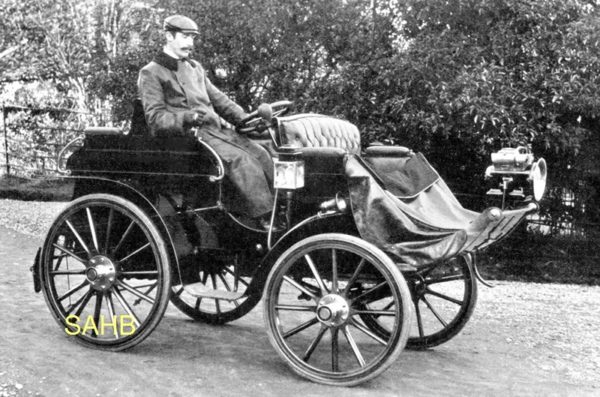
The driver of this 12hp Arrol-Johnston is the Duke of Portland who played a notable rôle in the early days of motoring in Britain. During the 1,000-Miles Trial in 1900 his estate, Welbeck Abbey in Nottinghamshire, provided a course for one of the speed trails that occurred – the first such event over a measured mile to take place in England. The same venue was used in 1903 during the Eliminating Trials for the selection of the British team of cars for the Gordon Bennett race. The Duke presumably liked unconventional cars as the Duchess had a 10hp Lanchester, and his own mount was unorthodox – and not just because of its horse-drawn appearance.
Engineer George Johnston of Glasgow had his first car on the road in 1895 and in 1898 the ‘Mo-Car Syndicate Ltd’ was registered with financial backing coming from Sir William Arrol, the civil engineer who had overseen the building of the Forth Bridge. The first Arrol-Johnston motor carriages built by the Syndicate seem to have been sold late in 1899.
The cars had unusual engines mounted in the middle of the chassis, these being two-cylinder horizontal units of the opposed-piston format, combustion taking place between each pair of pistons. The horizontal con-rods from the pistons were connected to vertical rocking levers and from these there were two lower con-rods that operated the centrally-placed crankshaft. The internals of the engine were incorrectly described in the book Lost Causes of Motoring (1966) and unfortunately the erroneous information therein continues to be repeated.
On the subject of errors, in 2010 a book published by ‘SAE International’ appeared with the title Opposed Piston Engines. The blurb on the back in part states: “provides the first comprehensive description of all documented opposed piston engines from 1887 to 2006”.Owners of surviving early Arrol-Johnstons will not be alone in being amazed to find from the text that the incorrectly spelt Gobron-Brille (Brillié) was the only successful opposed-piston automotive application in the pre-Great War era. There were actually a significant number of other automobiles in the same period that had such engines. The makes Bardon, Koch, and Saurer, will serve as examples to demonstrate the point.
Arrol-Johnston cars despite their rather old fashioned looks sold steadily over a six-year period and were well-suited to coping with the rugged terrain of their homeland. They were not sluggards either. In 1905 the first Tourist Trophy race was won by a modernised Arrol-Johnston with a lower chassis and of conventional appearance – powered by a front-mounted horizontal two-cylinder opposed-piston engine.







I’ve found that my grandfather, who lived in Dunfermline, ordered an Arrol Johnson direct from the factory the 1920’s. Are there any records from the factory?
Never having driven a car before, he collected the car from the factory, drove home to Dunfermline which unnerved him, and he then refused ever to drive a car again.